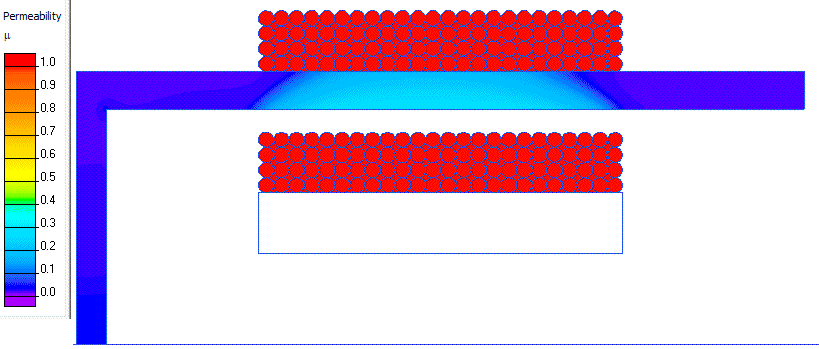Fault current limiter transients
QuickField simulation example
This simulation example is prepared by Professor James R. Claycomb as a part of the webinar Fault Current Limiter Simulations using QuickField.
An inductive superconducting current limiter protects the primary circuit. When the high voltage surge arrives, the current should be limited. The superconductor effectively screens the secondary winding.
When the fault occurs, the current increases many times, and its magnetic field causes the superconductor to come to a normal state. The secondary winding is no more screened and effectively increases the impedance of the circuit, thus limiting the fault current.
Problem Type
Axisymmetric problem of Transient magnetics.
Geometry
Given
Core is made of mu-metal with permeability of 10000.
Winding number of turns is 96, conductor diameter is 1 mm, copper conductivity is 56 MS/m.
AC current frequency is 60 Hz. The high voltage surge increases the voltage from the normal level of 1 V to 100 V.
Superconductor permeability is a non-linear function of the magnetic field strength:
Task
Calculate the fault current as a function of time.
Solution
The voltage source magnitude is defined by this equation: (1+99*step(t-0.1)) * sin(360*60*t). It is a 60 Hz sine-function with a pulsed magnitude. While (t-0.1)≤0 the step-function yields zero. Thus, the magnitude is (1 + 99*0) = 1 V. When (t-0.1) becomes positive, the step-function yields 1 resulting in the increase of sine magnitude to (1 + 99*1) = 100 V.
It is considered that 30 points is enough to accurately approximate the sinewave, so the integration time step is chosen to be Δt = (1/f)/30 = 0.0005555 sec.
Results
Superconductor permeability periodic variation in time follows the periodic variation of the current in the primary winding. At the low current value, the superconductor permeability is low. At the high current value the superconductor becomes normal with its permeability equal to 1.

The ratio of the secondary coil current magnitude to the primary coil current magnitude is 0.2 for a superconducting state of the superconductor. After the fault occurs at t=0.1 sec, the superconductor turns to a normal state and the ratio of currents in windings becomes 0.45. Thus, the secondary coil begins to limit the fault current in the primary coil.
- Video: Fault current limiter transients. Watch on Youtube
- Download simulation files (files may be viewed using any QuickField Edition).